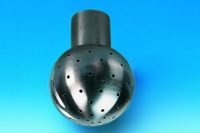Applied Technology: Spray Cleaning Automated at Dietrich's Milk

During the manufacturing process fluid milk is evaporated to 50% solids and then injected under high pressure into the 400° F environment inside the spray dryer where it flash dries. The dry milk then drops to the bottom of the unit and is discharged into bulk containers. Vibrators help remove any powder which may adhere to the sides of the cone. However, over time, the milk builds up on the inside of the dryer and must be removed during routine cleaning. In order to maintain high production efficiencies and product quality, close attention is paid to maintaining the cleanliness of the spray dryer interiors.
Until recently the company utilized traditional spray balls and high pressure water injection to clean the dryers. The routine cleaning cycle usually consisted of two 45 minute wash cycles utilizing a 2% sodium hydroxide caustic solution and a 1% nitric acid wash, interspersed with 20 to 30 minute rinses. A thorough cleaning of the entire unit often required up to 16 separate insertions of the spray ball by cleaning personnel into various openings throughout the dryer. This was a very time consuming, and labor- intensive operation to ensure that all the areas were cleaned. Water usage throughout the process was approximately 250 gals per minute.
With a standard cleaning process to measure against, Mgr. of Engineering and Maintenance, Tim Pacilio had the opportunity to install and utilize two rotary impingement cleaning machines manufactured by Gamajet Cleaning Systems, Inc. of Devault, Pa. The Gamajet 4 and Gamajet 8 cleaning machines are fluid driven tank cleaners that utilize the cleaning solution for power and provide 360 degree cleaning with low flow rates and high speed. Traditionally used to clean all types of storage and process tanks, this was the first application of a Gamajet unit in a spray dryer.
The Gamajet 4, because of its greater cleaning power, was inserted inside the large upper chamber and dome of the spray dryer, while the Gamajet 8 is positioned in the smaller sized bustle and cone located at the bottom of the unit. During the new cleaning cycle each Gamajet unit is inserted only once resulting in immediate savings in time and manpower.
With the new units, wash times have been reduced to a 15-30 minute cycle and often only one wash is necessary. Because of the Gamajet's high powered cleaning force, water usage is now estimated to be about 100 gals per minute.
"We estimate that by using the two Gamajet units, we save about two and a half hours in time and around 7,500 gals of rinse water per cleanup, Pacilio says. "And, we also save on the amount of chemicals we use."
Gamajet Cleaning Systems
610/408-9940
sales@gamajet.com
www.gamajet.com
Looking for a reprint of this article?
From high-res PDFs to custom plaques, order your copy today!




